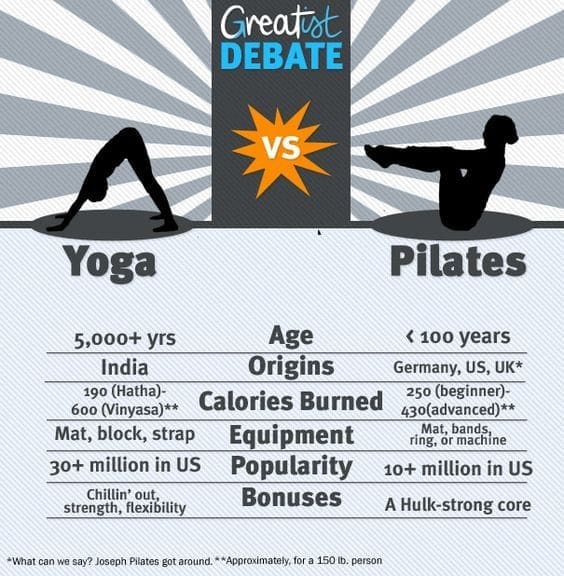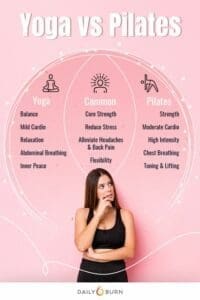Yoga Vs Pilates
Interested in uncovering the subtle nuances that distinguish Yoga from Pilates? While both Yoga vs Pilates practices highlight the mind-body connection, they offer distinctive approaches and advantages. This article demystifies the fundamental disparities between Yoga vs Pilates, delving into their historical roots, underlying philosophies, exercise methodologies, and breathing techniques. Whether you’re a devoted Yoga vs Pilates enthusiast or a dedicated Pilates practitioner, join us in exploring the unique attributes of each discipline. This exploration will provide you with clarity and assist you in determining which aligns best with your fitness goals and lifestyle.
Overall Goals
Yoga focuses on unity of mind, body, and spirit
Pilates aims to improve core strength and overall stability
When it comes to choosing a fitness practice, it can be overwhelming to decide which one is right for you. Yoga and Pilates are both popular forms of exercise that offer numerous benefits, but they have distinct differences in their goals. Yoga, rooted in ancient Indian tradition, focuses on the unity of mind, body, and spirit. Its overall goal is to promote overall well-being and inner peace. On the other hand, Pilates, developed in the early 20th century by Joseph Pilates, aims to improve core strength and overall stability. Its main objective is to strengthen the body’s powerhouse muscles, such as the abdominals, back, and pelvic floor. Understanding these overall goals can help you make an informed decision about which practice aligns better with your personal fitness goals and aspirations.
Origins and History
Yoga originated in ancient India over 5,000 years ago
Pilates was developed by Joseph Pilates during the early 20th century
The origins and history of yoga and Pilates significantly differ, showcasing their unique cultural backgrounds. Yoga, deeply rooted in ancient Indian traditions, has a history that dates back more than 5,000 years. It originated as a spiritual practice aimed at achieving self-realization and union with the divine. Over time, yoga evolved into a comprehensive system that encompasses physical postures (asanas), breathing techniques (pranayama), meditation, and ethical principles.
In contrast, Pilates emerged relatively recently, during the early 20th century, by the German-born Joseph Pilates. Originally called “Contrology,” Pilates was developed as a rehabilitation method for soldiers during World War I. Joseph Pilates believed that physical and mental health were interconnected, and his system aimed to strengthen both aspects simultaneously. Pilates gained popularity as a conditioning program for dancers and has since become widely practiced for its numerous physical benefits.
Philosophical Approach
Yoga incorporates spiritual and meditative aspects
Pilates is more focused on physical fitness and functional movements
The philosophical approach of yoga and Pilates differs significantly, reflecting their distinct intentions and purposes. Yoga is deeply ingrained with spiritual and meditative aspects that promote self-awareness and inner transformation. It encourages practitioners to cultivate a deep connection with their inner selves, fostering a sense of harmony between the mind, body, and spirit. The yogic philosophy emphasizes principles such as compassion, non-violence, and self-discipline, guiding practitioners towards a holistic way of life.
In contrast, Pilates is primarily focused on physical fitness and functional movements. While it may have some indirect mental and emotional benefits, the primary goal is to improve physical strength, endurance, and flexibility. Pilates aims to strengthen the core muscles, enhance overall stability, and improve body alignment. By engaging in precise movements with control and alignment, Pilates practitioners can develop functional strength that enhances their overall physical performance.
Breathing Techniques
Yoga emphasizes various breathing techniques known as pranayama
Pilates combines controlled breathing with movement for better engagement
Breathing techniques play a vital role in both yoga and Pilates, but their approaches differ, highlighting the divergence in their practices. In yoga, breath control is of paramount importance, and various breathing techniques, collectively known as pranayama, are incorporated. Pranayama techniques range from deep diaphragmatic breathing to more advanced breath retention practices. The breath is considered the bridge between the body and mind, and through conscious breathwork, practitioners can deepen their physical poses, relax the mind, and cultivate a sense of inner calm.
In Pilates, controlled breathing is an integral part of the practice, closely intertwined with movement. The breath acts as a guide, helping individuals engage the correct muscles and maintain proper alignment throughout the exercises. By synchronizing breath with movement, Pilates practitioners can enhance their body-mind connection and support optimal engagement of the targeted muscles. The emphasis on breathing in Pilates ensures that exercises are performed with precision, control, and flow.
Exercise Styles and Techniques
Yoga involves holding poses (asanas) for extended periods
Pilates consists of precise movements performed with control and alignment
The exercise styles and techniques utilized in yoga and Pilates differ, impacting the physical challenge and experience of each practice. In yoga, practitioners engage in a series of asanas, or poses, which are typically held for a certain period. The poses can vary in intensity, from gentle stretches to more physically demanding postures. Holding the poses for extended periods allows for deep stretching, strengthening, and energizing the body. Yoga sequences are often designed to create a flow between different postures, promoting a sense of grace and fluidity.
In contrast, Pilates focuses on precise movements performed with control and alignment. The practice utilizes a variety of exercises that target specific muscle groups, with an emphasis on the core. Each movement is executed with a deliberate and controlled manner, providing a unique combination of intensity and stability. Pilates exercises aim to improve body awareness, posture, and overall muscle tone.
Flexibility and Strength
Yoga improves flexibility while also building strength
Pilates focuses on developing core strength and overall muscle tone
While both yoga and Pilates offer physical benefits, their focus on flexibility and strength training differs. Yoga is renowned for its ability to improve flexibility. Through regular practice, individuals can achieve increased range of motion and enhanced suppleness in the muscles and joints. The combination of deep stretching and holding poses for extended periods helps to lengthen and release tension in the muscles. However, yoga is not solely focused on flexibility; it also builds strength through isometric contractions and maintaining postures.
In Pilates, the main emphasis is on developing core strength and overall muscle tone. The majority of the exercises performed in Pilates engage the deep abdominal muscles, along with other key muscle groups such as the glutes, back, and hips. By targeting the powerhouse muscles, Pilates aims to improve overall stability, body alignment, and postural strength. Though Pilates also improves flexibility, it places less emphasis on intense stretching compared to yoga.
Equipment Usage
Yoga primarily uses a mat, but props like blocks and straps can be utilized
Pilates incorporates specialized equipment such as reformers and resistance bands
The equipment used in yoga and Pilates significantly varies, providing distinct experiences and additional options for practitioners. Yoga primarily relies on a mat, which provides cushioning and stability for various poses. However, yoga props such as blocks, straps, bolsters, and blankets can also be incorporated to support and enhance the practice. These props assist in achieving proper alignment, increasing accessibility for individuals with different body types or flexibility levels.
In contrast, Pilates incorporates specialized equipment designed to enhance the practice and provide targeted resistance. The most well-known piece of Pilates equipment is the reformer, a sliding carriage apparatus with various springs and pulleys. The reformer allows for a wide range of exercises that promote strength, flexibility, and control. Other equipment used in Pilates includes the Cadillac, Wunda Chair, and resistance bands, which add variety and challenge to the workouts.
Inclusivity
Yoga can be modified for all ages and fitness levels
Pilates can also be adapted, but some exercises may require a certain level of strength
Both yoga and Pilates can be modified to accommodate different ages and fitness levels, but there are certain considerations to keep in mind. Yoga offers various styles and levels of intensity, making it accessible to individuals at different stages of their fitness journey. Beginners can start with gentle styles like Hatha or Restorative yoga, gradually progressing to more vigorous forms like Vinyasa or Ashtanga. Additionally, modifications and props can be utilized to adapt poses for individuals with physical limitations or injuries.
Similarly, Pilates can be adapted to suit different fitness levels and abilities. However, some exercises in Pilates may require a certain level of strength or body awareness to be performed safely and effectively. Individuals who are new to Pilates or have specific health concerns should consider working with a qualified instructor to receive proper guidance and modifications. With the right instruction and modifications, both yoga and Pilates can be enjoyed by a diverse range of individuals.
Injury Rehabilitation
Yoga offers various poses and stretches to aid in injury recovery
Pilates focuses on core stability and can be beneficial for rehabilitation
Both yoga and Pilates can be beneficial for injury rehabilitation, offering unique approaches to support recovery and healing. In yoga, various poses and stretches can aid in injury recovery by promoting flexibility, strengthening the surrounding muscles, and improving range of motion. Yoga’s emphasis on breathwork and mindfulness can also help individuals develop better body awareness, allowing them to avoid potential re-injuries and move in harmony with their bodies.
Pilates, on the other hand, focuses on core stability and can be particularly advantageous for rehabilitation purposes. The precise movements and controlled exercises in Pilates help individuals develop a strong core, which plays a key role in supporting and stabilizing the body. By improving core strength and stability, Pilates can assist in recovering from injuries, enhancing overall body mechanics, and preventing future imbalances or strains.
Popular Class Styles
Yoga: Hatha, Vinyasa, Ashtanga, Bikram, Yin, Restorative
Pilates: Classical, Contemporary, Reformer, Mat, Tower
Yoga and Pilates offer a diverse range of class styles, each with its own unique characteristics and benefits. In yoga, popular class styles include Hatha, Vinyasa, Ashtanga, Bikram, Yin, and Restorative yoga. Hatha yoga focuses on the alignment of body and breath, making it suitable for beginners. Vinyasa yoga, known for its flowing sequences, offers a more dynamic and energetic practice. Ashtanga yoga follows a specific series of postures, while Bikram, practiced in a heated room, promotes detoxification and endurance. Yin yoga involves passive stretching and long holds, while Restorative yoga provides deep relaxation and rejuvenation.
In the Pilates realm, class styles can be categorized into Classical, Contemporary, Reformer, Mat, and Tower Pilates. Classical Pilates follows the original teachings and principles of Joseph Pilates. It emphasizes a structured workout, utilizing specific exercises and sequences. Contemporary Pilates, on the other hand, incorporates modern adaptations and variations into the practice. Reformer Pilates utilizes the reformer machine to enhance resistance and challenge. Mat Pilates focuses on exercises performed on a mat without the need for equipment, while Tower Pilates utilizes specialized equipment to target specific muscle groups.
In conclusion, yoga and Pilates offer distinct approaches to fitness and well-being. While yoga focuses on the unity of mind, body, and spirit and emphasizes spirituality and flexibility, Pilates aims to improve core strength, stability, and overall muscle tone. Understanding the origins, philosophical approaches, breathing techniques, exercise styles, and equipment usage in yoga and Pilates can help individuals make an informed decision about which practice aligns better with their goals and preferences. Whichever path is chosen, both yoga and Pilates have a multitude of benefits to offer, providing opportunities for personal growth, physical transformation, and overall holistic well-being.
Disclaimer
The content is purely informative and educational in nature and should not be construed as medical advice. Please use the content only in consultation with an appropriate certified medical or healthcare professional


